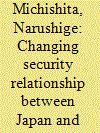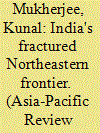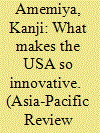|
|
|
Sort Order |
|
|
|
Items / Page
|
|
|
|
|
|
|
| Srl | Item |
| 1 |
ID:
135936


|
|
|
|
|
| Summary/Abstract |
The Asian Women's Fund's atonement project for former comfort women set a new vision of Japan in which the people along with the Japanese government proactively participate in performing the moral responsibility for the suffering of former comfort women in cross-boundary and cross-generational ways. This article argues that the Fund's imperfect reconciliation with former comfort women particularly in Taiwan and South Korea was due to the misunderstanding about moral responsibility as an evasion of the Japanese government's legal responsibility and due to the inadequate exercise of political and administrative leadership. Underneath these factors lie the intertwined root causes of the limited availability of facts on the issue of comfort women and the ideologically driven discourse. The article suggests the following measures as a further atonement project: strong political leadership to present the clear meaning of moral responsibility, cooperation with the governments and support groups in the victims' countries, and an international truth investigation
|
|
|
|
|
|
|
|
|
|
|
|
|
|
|
|
| 2 |
ID:
135932


|
|
|
|
|
| Summary/Abstract |
Japan has long played the role as the main operating base for Korean contingencies. It has also provided rear-area logistic support to the US forces fighting in Korea and helped South Korea build up its defense industrial base. However, the Japan-South Korea relationship has deteriorated in recent years due to short-term political and long-term economic and strategic reasons. At this point, South Korea is bandwagoning with China and deemphasizing its relationship with Japan. China-South Korea relations are not without problems, however, and Japan regards South Korea as one of the most important potential strategic partners in maintaining stability in Asia. In the future, the most decisive factor in determining the direction of the security relationship between Japan and South Korea will be China.
|
|
|
|
|
|
|
|
|
|
|
|
|
|
|
|
| 3 |
ID:
135934


|
|
|
|
|
| Summary/Abstract |
The EU calls itself a “soft power,” making “soft power” contributions to Asian security. That is undoubtedly what the EU is and does in Asia and the track record of European contributions to Asian peace and stability through economic and financial as well as development aid and technical assistance over the decades is not unimpressive. As will be shown below, over recent years Brussels and the Union's individual member states have sought to increase their involvement and role in Asian “hard security,” attempting to get rid of its reputation of being security a “free-rider” enjoying but not sharing the burden of US regional security guarantees. While the EU will continue to be a “hard security” actor in Asian security within limits, it is advised to concentrate its security cooperation with like-minded partners such as Japan and the US as opposed to hoping that talking to Beijing on regional or global security issues produces tangible results. As will be shown below, it clearly does not as Beijing continues to conduct very assertive and at times aggressive regional foreign and security policies insisting on the “principle of non-interference” in Chinese domestic and foreign policies. Consequently, EU influence on Chinese foreign and security policies in general and its increasingly aggressive policies related to territorial claims in the East China and South China Seas will continue to exist on paper and paper only.
|
|
|
|
|
|
|
|
|
|
|
|
|
|
|
|
| 4 |
ID:
135937


|
|
|
|
|
| Summary/Abstract |
The paper tries to analyze the different layers of the conflict in the remote Indian northeast. It looks at the different facets of this conflict, and argues that the conflict in the Indian northeast exists at many different levels. In relation to the different facets of the conflict, the paper has a special focus on human rights abuses, poverty, corruption, poor governance, administrative failure, the role played by external actors, and draconian laws such as the Armed Forces Special Powers Act. Most of the conflicts have been associated with strong separatist tendencies and the issue of migration. The levels of violence have differed from place to place within the region. While violence has been successfully dealt with by the Indian government in states like Mizoram, the situation in states like Assam, Manipur, and Nagaland seems to be a work in progress. Assam, Manipur, and Nagaland have witnessed very high levels of violence since 1947, when India became independent from British colonial rule, until the present day. Methodologically, the paper follows a bottom up approach, and, to get first-hand information about the conflict, a series of interviews was conducted recently with some of the local residents of the region. The paper suggests demilitarization and infrastructure development in the region as the way forward.
|
|
|
|
|
|
|
|
|
|
|
|
|
|
|
|
| 5 |
ID:
135939


|
|
|
|
|
| Summary/Abstract |
China's rise and clear ambition to change Asia poses both tactical and strategic questions, long neglected in Japan. Tactically, territorial challenges can be countered effectively by use of Anti-Access Area Denial [A2/AD] tactics, as Japan is now doing. The strategic issues: how to deal with a hostile nuclear super-power neighbor, counter nuclear blackmail, and so forth, are far more difficult. This author believes that US “extended deterrence” no longer exists. Washington in fact would never use nuclear weapons to defend Japan, whatever promises have been made. The only answer, and one that decreases rather than increases the possibility of conflict, is for Japan to acquire within a decade a minimal nuclear deterrent, too small for war-making but adequate to prevent attack, such as those maintained by Britain and France, who know America best. Without such a deterrent Japan will be defenseless against inevitable Chinese nuclear threats and blackmail.
|
|
|
|
|
|
|
|
|
|
|
|
|
|
|
|
| 6 |
ID:
135935


|
|
|
|
|
| Summary/Abstract |
With Japan viewing Southeast Asia as its natural sphere of influence and a region of immense economic complementarities and potential, it was no surprise that Japan moved quickly in the post-war period to shore up and rebuild its influence in this strategically vital region as the European colonial powers departed from Southeast Asia. Using reparations, followed by aid and trade, Japan soon became a key economic and strategic state actor in Southeast Asia.
Providing a valid counterpoint to communism, Japan proved an attractive economic model that enabled it to grow its influence in the region substantially. Using deft and low-profile diplomacy Japan became an economic leader and driver of economic growth and prosperity in Southeast Asia, supplementing and supporting US Cold War regional objectives. During times of conflict, Japan worked to reduce tensions and restore order using its unique brand of Asian diplomacy, not losing sight of its long-term goal of integrating the region economically and fostering regional peace and stability.
|
|
|
|
|
|
|
|
|
|
|
|
|
|
|
|
| 7 |
ID:
135931


|
|
|
|
|
| Summary/Abstract |
Since the inauguration of the second Abe cabinet in December 2012, there have been many important developments in the area of security policy. This article examines each new policy and how it fits in to the National Security Strategy principles of a “proactive contribution to peace” and international cooperation. It concludes with a comparison of the new policies with those of other major world powers and a discussion of the main source of opposition to Japan's security policy.
|
|
|
|
|
|
|
|
|
|
|
|
|
|
|
|
| 8 |
ID:
135933


|
|
|
|
|
| Summary/Abstract |
Rarely before has such a large and potentially consequential country tried to reform itself politically and economically as Myanmar is now attempting, following an extended period of extreme isolation and amid unprecedented international and digital connectedness that exists today. This is a challenge not only for Myanmar, but also for the United States and Japan as they try to facilitate this transformation in productive ways, in a coordinated fashion, and consistent with their own foreign policy and commercial interests. A pertinent question, therefore, is whether or not Washington and Tokyo are inclined and prepared to address Myanmar's transition as an alliance issue, and if they are, then what is an efficient and effective way to go about this task.
The answer is mixed, for despite their pursuit of many common interests, the policy priorities and policy making environments in the United States and Japan differ significantly. In simple terms, the United States has a “democracy first” agenda in Myanmar that sometimes limits its options, while Japan takes a more flexible approach in order to maximize engagement and business opportunity. Still, President Obama and Prime Minister Abe provided a mandate in April 2014 to strengthen alliance cooperation in Southeast Asia (and in Myanmar in particular), and the two countries have complementary strengths and local networks that can be leveraged more effectively for the benefit of all.
Despite US concerns about stalled political liberalization and human rights abuses in Myanmar, Washington should take a longer-term horizon for evaluating reforms and consider enhancing its leverage with Myanmar through more effective policy coordination with Japan (which is a major player in the country), rather than the maintenance or reapplication of sanctions.
|
|
|
|
|
|
|
|
|
|
|
|
|
|
|
|
| 9 |
ID:
135938


|
|
|
|
|
| Summary/Abstract |
The word “innovation” tends to bring to mind the USA, rather than Europe or Japan. In the ICT industry, in particular, revolutionary companies such as Apple, Amazon, Google, and Microsoft have succeeded in bringing about numerous innovations. Because of this, it has become second nature to think of innovation as a US phenomenon. What, then, gives rise to so much innovation in the USA? In this article, the author will first provide an overall view of innovation from the perspectives of economics and of management theory and examine the ways in which innovation has been interpreted and defined. Then, the author will consider the question of why the USA is so innovative as a nation from the three perspectives of its historical background, national character, and systems supporting innovation. It will be demonstrated that one of the characteristics of innovation—discontinuity—is well entrenched in the USA, as is a national character that stresses individualism and a culture that forgives failure. The author will suggest that new innovations will continue to be the driving force of US economic growth into the future.
|
|
|
|
|
|
|
|
|
|
|
|
|
|
|
|
|
|
|
|
|